The Best Dives in Mexico's Baja California Sur
Between its spectacular desert, inspiring mountain landscapes and the lapping waters of the Pacific Ocean and Sea of Cortez nearly surrounding it, Mexico’s Baja Peninsula is easily one of the most beautiful places in the world.
Its diverse landscape offers distinct experiences for different travelers, from the glitzy resort and golf playground of Cabo San Lucas to the sandy backroads that draw surfers and vanlifers to remote beach breaks and lonely camp sites. For divers, Baja’s treasures are largely concentrated in the peninsula’s southernmost state, Baja California Sur where the Sea of Cortez dazzles with its sheer abundance and diversity of marine life.
If you want to hit as many sites as possible in one go, start your explorations in the very south around Cabo San Lucas. Make your way north about six hours by car through starkly beautiful cactus-covered landscapes to the restful hamlet of Loreto, spending a few days along the way in the state capital of La Paz, known for whale sharks, sea lion colonies and manta sightings.
Here are just a few of the don’t miss dives to put on your list in Baja California Sur—from a surprising spot right outside the busy marina in Cabo San Lucas to a magnet for giant Pacific mantas offshore from La Paz.
Pelican Rock, Cabo San Lucas
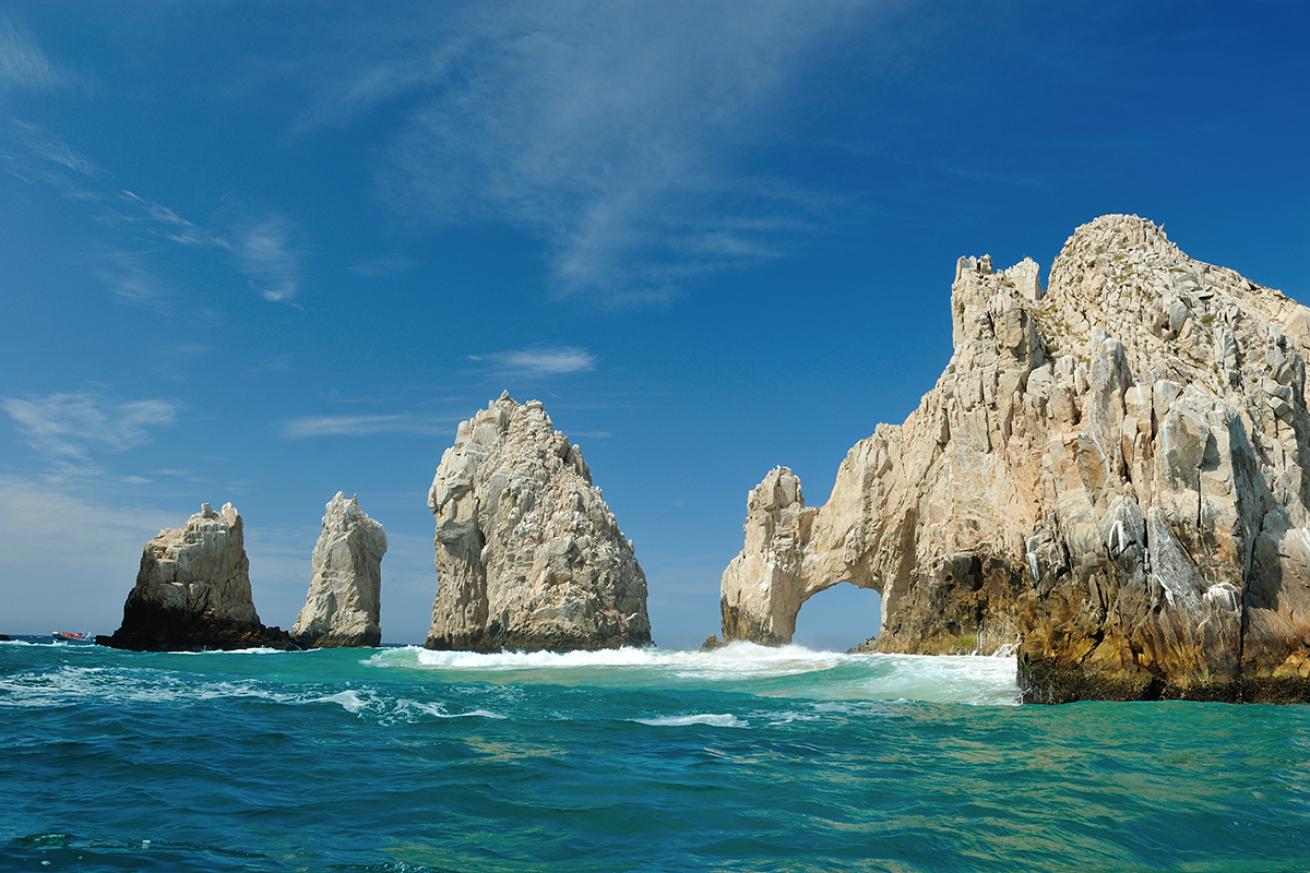
Shutterstock.com/PixieMePelican Rock
A five-minute cruise from the marina in Cabo San Lucas, where tourists down margaritas at Señor Frogs, brings you to a far more intoxicating dive site that wows with shallow wonders.
Rising like a rocky finger from the calm water near the shoreline, Pelican Rock often has a sea lion or two lounging astride it. But the real show is underwater.
“The sheer amount of life that can be found around this small, shallow pinnacle is mind blowing,” says Jay Clue, owner of Cabo San Lucas-based Dive Ninja Expeditions, which runs regular dives to the site. “Everything from massive resident schools of snapper to white tip reef sharks, turtles rays, eels, octopus. The list just goes on and on at Pelican Rock.”
Macro fans look for seahorses, nudibranchs and even frog fish here. And the surprise of what might lurk out in the blue on any given dive that adds to the site’s appeal, too, says Clue.
“I’ve seen a passing whale shark, massive schools of mobula rays, a curious humpback and even a pair of smalltooth sand tiger sharks while diving around Pelican Rock.”
Land’s End
Cabo San Lucas’ arch (called El Arco) steals the spotlight topside, with this spectacular formation often the backdrop for breaching humpback whales that migrate past here during the winter months.
Divers who head underwater at Land’s End, right next to El Arco, might hear whale song and be treated to other amazing views, too, including sea lions from then nearby resident colony performing their underwater acrobatics.
You can start your dive here in the Sea of Cortez and finish it in the Pacific Ocean, finning through a fish-filled canyon and weaving through a small wreck that’s often covered with baitfish (look for guitarfish in the sand). During the summer months, large schools of devil rays can often be seen cruising through the blue. It’s hard to believe the city marina is just a ten-minute cruise way.
Cabo Pulmo National Marine Park
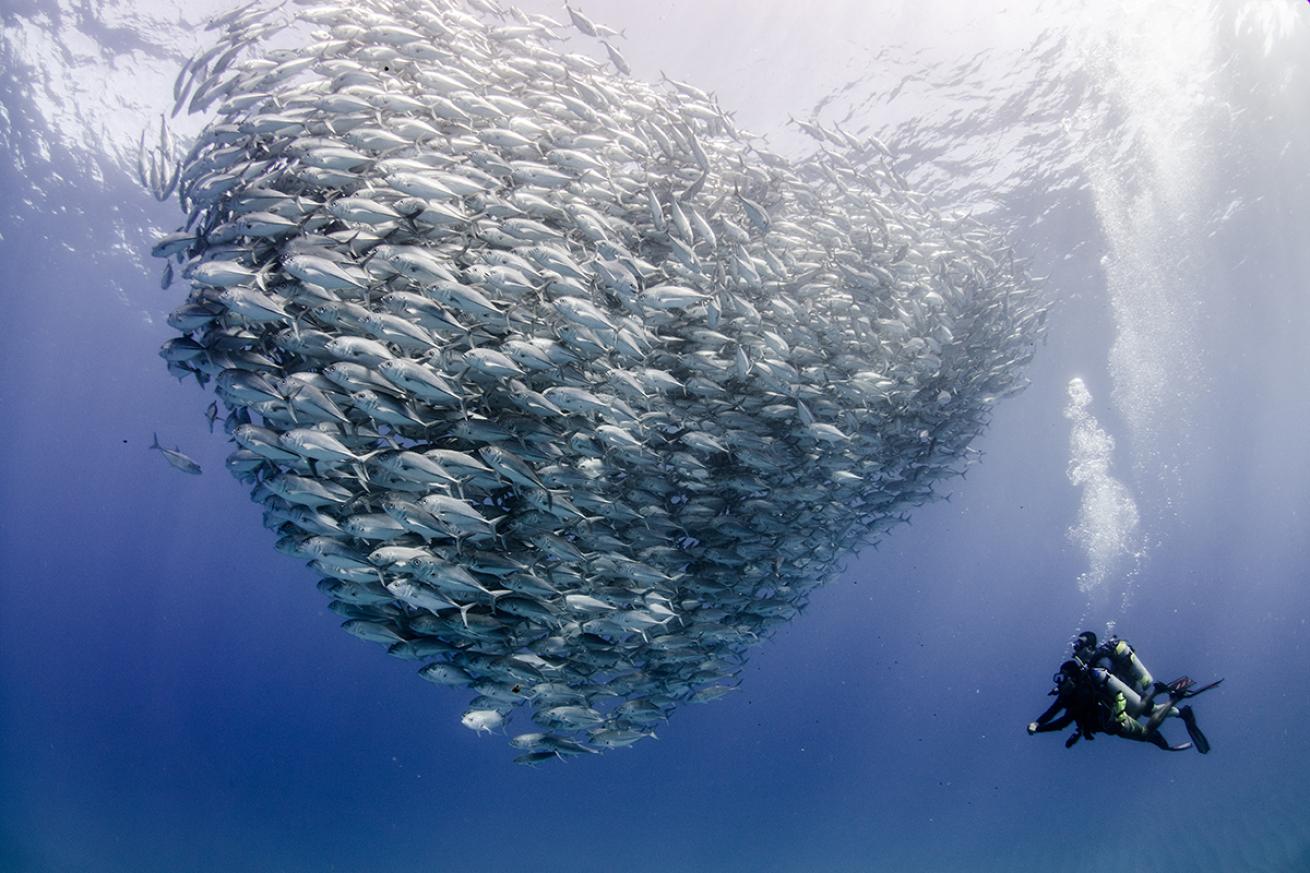
Shutterstock.com/Leonardo GonzalezDivers encounter a school of bigeye trevally in Cabo Pulmo National Park.
If you’re the kind of diver who likes nothing more than finding yourself finning inside a vortex of shimmering scales and hundreds of fishy eyes that twitch every which way — (raises hand) — then there’s no schooling fish dive quite like the one at Cabo Pulmo.
From the surface, you can already see the dark school of jacks swarming tornado-like under the boat.
"I think every diver should experience it at least once in their life,” says Clue about diving with the schooling jacks in Cabo Pulmo. “The immense size of the school alone is jaw-dropping and a true testament to the great things marine protected areas can do for our oceans.”
Bull sharks and sea lions can also often be spotted here.
Gordo Banks
Just ten miles off San Jose del Cabo, two seamounts act as a magnet for schooling hammerheads, schooling jacks, mobulas, tuna and more. Gordo Banks can be reached by day boats and, when it delivers, is like diving a remote locale that requires a liveaboard.
“Like most offshore sea mounts, this is one of those places that can be a bit of a roll of the dice,” says Clue. “But when it’s good, it’s insane.”
From April to June, divers might get lucky and see silky sharks here, too.
“Some of the best dives I've had in Mexico, if not the world, have been at Gordo Banks,” says Clue. “Imagine diving with a school of a couple hundred hammerheads and then coming up to do your safety stop just to have mother and calf humpbacks whale swim past to check you out.”
It doesn’t happen every day of course, but the possibility of such an encounter is always there at Gordo Banks, he says.
Neptune’s Finger
Here’s yet another favorite dive site within just a ten-minute boat ride of the Cabo San Lucas marina. The reef at Neptune’s Finger starts at about 15 feet and drops to over 500 feet down a vertical wall. You’ll regularly see turtles and all manner of tropical fish patrolling. But the real spectacle to catch at Neptune’s Finger is down around 100 feet where, when conditions are right, you can see a sandfall (an underwater cascade of flowing sand) sweeping down the wall into the abyss.
“It has to do with surge and swell. But basically, water moving the sand above kicks off an avalanche,” says Clue. Admire it, to be sure, but definitely don’t follow it down too far—the bottom is way down at over 3,000 feet in these parts.
Los Islotes and El Mogote
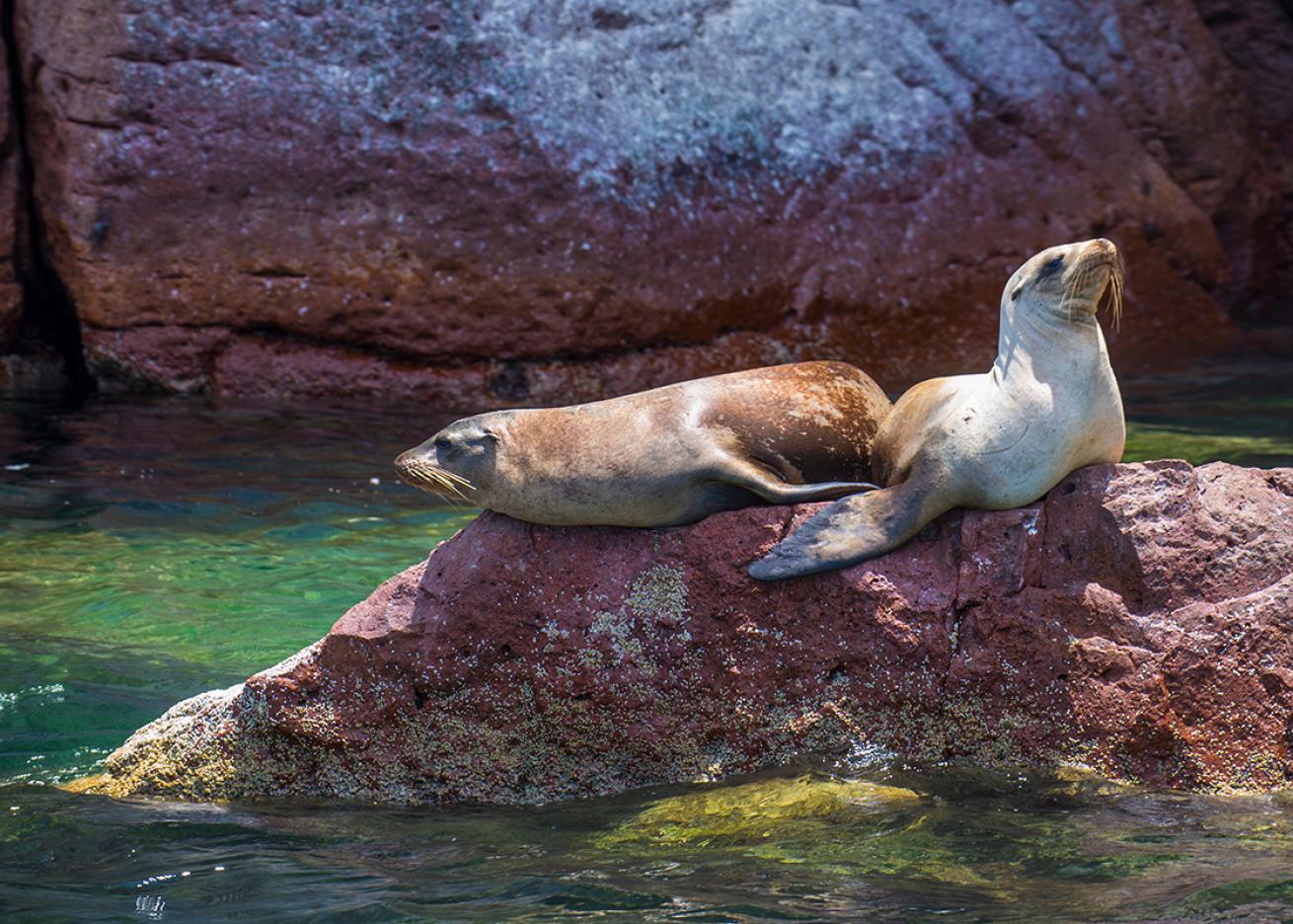
Shutterstock.com/VG FotoSea lions lounge at Isla Espiritu Santo.
The best full-day of diving from La Paz, the capital of Baja California Sur, starts with a snorkel session and takes place during whale shark season, from October to May.
That's when you can motor out just 15 minutes from the docks at The Cortez Club snorkel the shallows off El Mogote peninsula (a long sand bar) with the juvenile whale sharks here to filter feed on rich plankton concentrations during the winter months.
The two dives that follow might be any combination of awesomeness, but usually include a visit to the colony of hundreds of California brown sea lions off Espiritu Santo Island at Los Islotes. You can fin into a narrow sea cave where you might find juvenile sea lions peering down at you from rocks and see scores more, including alpha males turning tricks in the shallows in the open water.
A dive at San Rafaelito—an islet much closer to La Paz and home to more sea lions and beautiful shallow reefs covered with corals—is often on the itinerary for a full day of diving, too.
El Bajo
About eight miles from Los Islotes, off La Paz, El Bajo is another offshore seamount in the Sea of Cortez that’s a magnet for schooling hammerheads, as well as amber jacks and tuna.
Due to currents and the open water conditions of the site, the dive is suitable for divers with Advanced Open Water certification. And what makes the site so exciting, says Curtiss, is that you never know what you might see.
“The mystical seamounts of El Bajo seem to attract giants from the deep such as schooling hammerheads, silky sharks and whale sharks,” he says. “That makes each dive there so unpredictable—and so memorable, too.”
La Reina
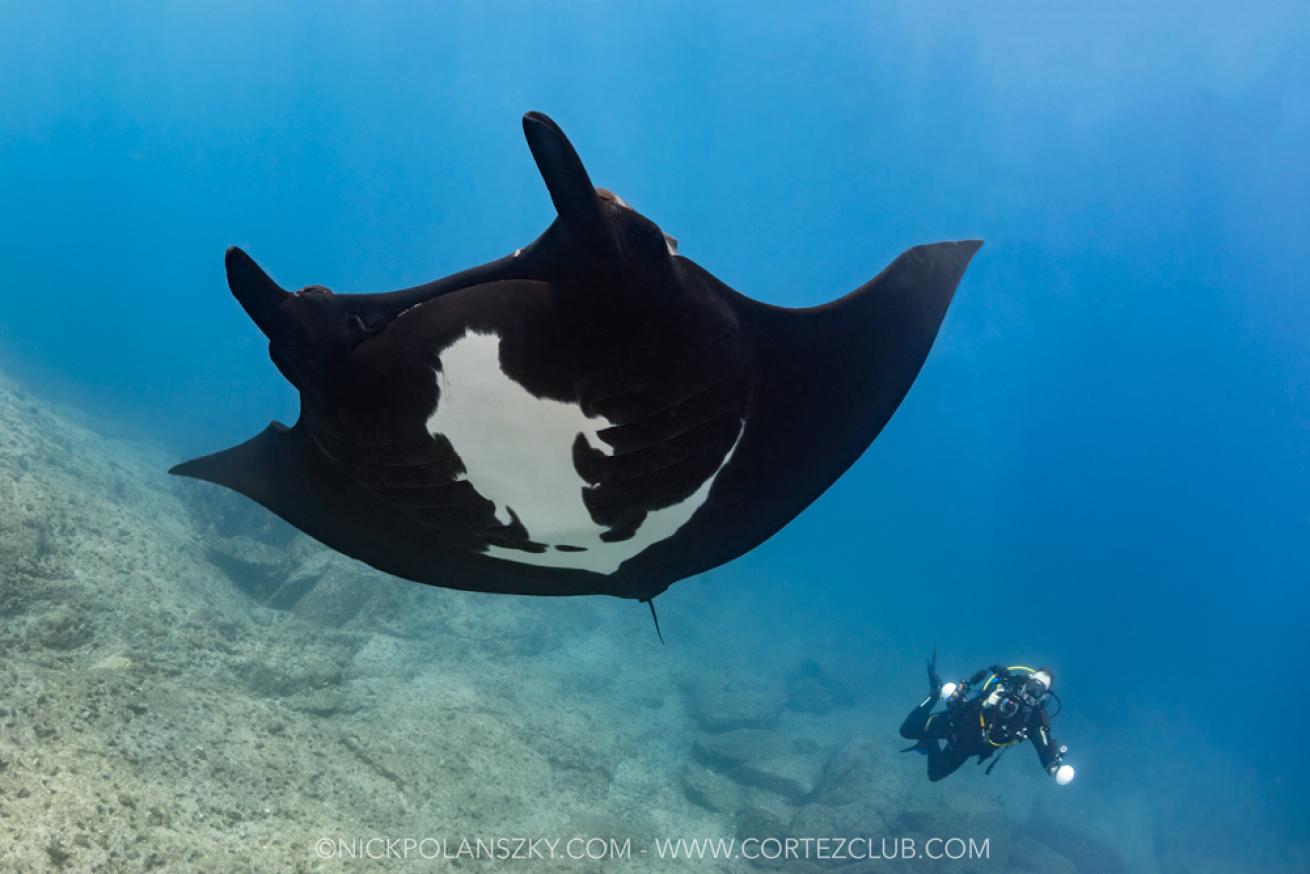
Nick Polanszky/Cortez ClubA giant Pacific manta ray soars past a diver at La Reina.
Off the northern tip of Cerralvo Island, the dive site called La Reina is a good place to see giant Pacific manta rays, which recently returned to the small islet after a hiatus of more than 15 years. The mantas may be using the area as a cleaning station — they're principally seen here between the months of June to October, but the site is beautiful to dive year round.
You’ll dive in search of them in waters about 80 feet deep off the small islet north of Cerralvo, where the reef is covered with gorgonians and brain corals and zebra and jeweled morays can often be seen peeking from crevices.
The mantas "glide gracefully around the small island,” says James Curtiss of The Cortez Club, which runs regular trips from La Paz to dive La Reina. All divers have to do is relax near the bottom and watch the show.
La Salvatierra
You don’t have to be an advanced diver to go down on the wreck of La Salvatierra, a hunk of rusting metal about 60 feet deep that has amassed all manner of marine life since being submerged since 1976. The wreck’s propellers are exposed and you can see the trucks—many with tires still inflated—that were the ship’s cargo.
It’s a good place to see large grouper and a resident sea turtle Curtiss once freed from being entangled by a fishing line, he says.
Piedra Blanca
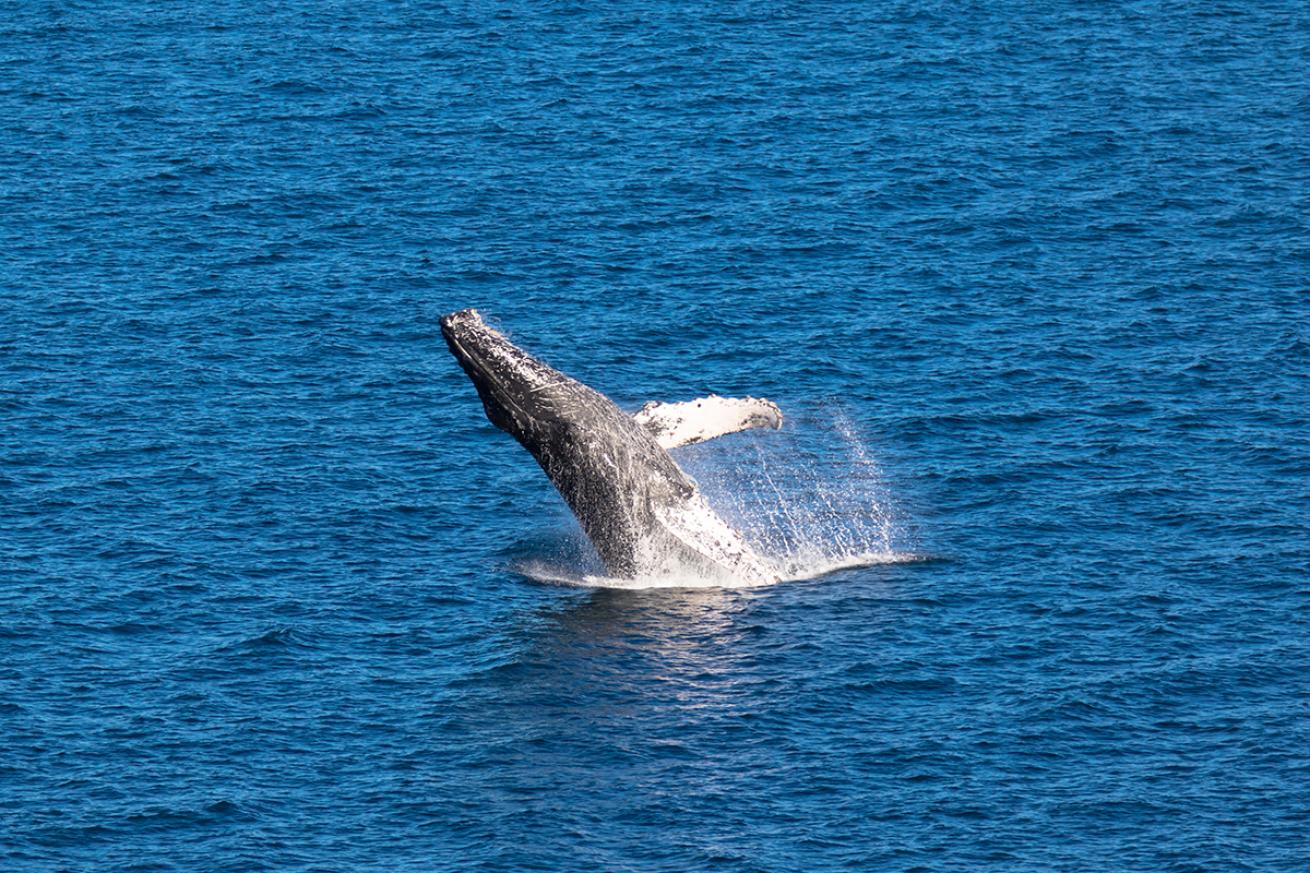
Ian KennedyA humpback whale breaches in the waters of Loreto.
A beautiful desert drive with views of mountains that descend nearly to the sea brings you four hours north of La Paz to the quiet Loreto. Boat rides of an hour or less from the town marina bring you to several great dive sites protected by islands and the calm waters within the Loreto Bay National Marine Park.
The best dive is at the pinnacles of Piedra Blanca. It’s usually dived as a drift and brings you along a wall sliced with large fissures and teeming all over with tropical fish—trigger fish, angel fish, sergeant majors and much more. Look for black coral in the deeper sections and purple gorgonians waving all over the place, too, as you float along a veritable conveyor belt of marine life.










